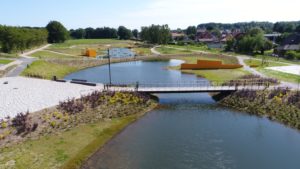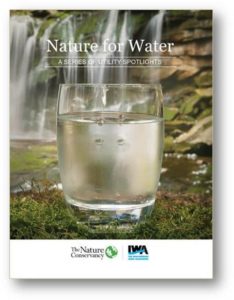Climate Change adaptation using Nature-based Solutions
The Danish water utility Skanderborg Forsyning affirms that when it comes to water security in a changing climate, using nature-based solutions at the local level was never a question. Climate change projects are an opportunity to adapt using nature to deal with increased rainfalls and prevent the flooding of urban areas.
“We use the best long-term solutions we can find. The fact that climate change adaptation actions can support natural habitats and biodiversity is an added bonus. For the most part, nature-based solutions or green infrastructure are the most efficient at filtering rainwater, addressing flooding issues and adapting to local circumstances”, explains Project Manager Jesper Brix Kjeldsen, the expert responsible for climate change adaptation at Skanderborg Forsyning
In recent years, the municipality of Skanderborg, located in Eastern Denmark, has experienced increasing and more frequent rainfall resulting in extensive flooding of urban areas. Rainwater accumulation can lead to sewerage overflow and surface water quality degradation, impacts that will be exacerbated by the onset of climate change.
Skanderborg Forsyning has faced public criticism for the poor water quality in lakes, providing an incentive for greater community engagement and targeted efforts to unlock the full value of water. Consequently, the Municipality has developed a climate change action plan to identify vulnerable areas and address flooding.
How does the city of Skanderborg plan and implement NBS?
Within the Municipality’s climate change action plan, Skanderborg Forsyning is involved in 12 climate adaptation projects, many of which have NBS elements. The Municipality is considered the project owner or lead and involves the utility as project supervising engineers. In practice, this is a joint partnership, where the Municipality finances the green infrastructure or NBS through taxes and the Municipality and utility apply for co-financing from the Secretariat for Water Supply or “Forsyningssekretariatet”.
The Secretariat is the Danish economic regulator for water utilities under the Danish Competition and Consumer Authority (Danish Competition and Consumer Authority, 2019). If the utility’s request for funding is approved, they are permitted to allocate funds from the water tariff to finance the climate change adaptation project, enabling a co-financing model supported by utility and consumer.
The regulatory details are available in the Guidance on wastewater companies’ co-financing of climate projects which is anchored in the Danish Competition and Consumer Authority (Forsyningssekretariatet, 2017). The projects developed in partnership between the utility and Municipality capitalize on the capabilities of citizens and the Municipality.
The involvement of Skanderborg Forsyning demonstrates how a water utility can address climate threats by investing in their system through NBS and creating business opportunities with beneficial societal outcomes. Although these projects are not explicitly referred to as “nature-based solutions”, they are inherently nature-based and capitalize on the potential of natural infrastructure like lakes to capture and store rainwater, and forests to protect the water supply.
The development of several recreational parks with rainwater lakes and forests has been a central focus of Skanderborg Forsyning’s work with the Municipality. The strategic positioning of these projects enables them to have an impact on flooding threats and support climate resiliency, while simultaneously delivering benefits to the surrounding community.
In the case of Låsby Lake Park, Skanderborg Forsyning transformed a former industrial site into a shared community space that could accommodate excess rainwater and protect Låsby’s 2,000 citizens against increasing flood risks (Aquaglobe, 2019). This area’s downward sloping terrain made it susceptible to intense flooding even during brief bursts of rainfall. Residents had expressed a pronounced desire for an area to congregate and their ideas and active participation played a decisive role in the design of the park.
At the heart of the park is a rainwater lake, which takes on different shapes depending on the level of rainfall and the depth of the lake. The lake’s steep and flat shores allow different entry points for residents, even when water levels are high. There are numerous paths that provide access from different parts of the town and a bridge that connects the town’s eastern and western regions. These design elements, including the carefully selected colour palettes for sculptures and athletic structures, reinforce a central theme of the park: accessibility for all.
Skanderborg Forsyning worked closely with a citizen group of Lasby residents from the conception phase in January 2013 through completion in 2016. Close to 900 ideas were submitted by residents during the project proposal phase and more than 100 residents attended each association meeting. The citizen group has even signed an agreement on the park’s management and maintenance to ensure long-term success. Skanderborg Forsyning is hopeful that this project will inspire others to deviate from traditional roles and be part of new collaborative efforts.
Rainwater lakes at Lasby Lake Park © SKANDERBORG FORSYNING
Close collaboration with the technical and environmental administration of the Municipality of Skanderborg and city council has been crucial to the success of Skanderborg Forsyning’s projects. To be funded as a climate adaptation project and co-financed by utility companies, projects must fulfill several criteria and illustrate the cost efficiency of these options compared to “ordinary” solutions. Skanderborg Forsyning presented a cost comparison using gravitational flow models that evaluated the difference between constructing underground pipes and pumping systems versus developing rainwater lakes that would capture and direct the water above ground.
Across the 12 different co-financed projects, they demonstrated an average savings of 72%, which included using NBS as part of their climate adaptation approaches. The Municipality of Skanderborg is involved in all projects dealing with water above ground that involve use of roads and public property, like Lasby Lake Park While Skanderborg Forsyning staff serve as supervising engineers, the Municipality provides valuable internal capacity for climate adaptation projects by employing a designated climate coordinator. Equally important to securing a strong partnership with the Municipality is maintaining involvement with city councils.
Skanderborg Forsyning is a private utility yet it is 100% publicly owned, which means that the Municipality acts as both an owner and partner of the project. As local residents, city council members are often experiencing the impact of flooding first hand. If they are not aligned on utility efforts along with the Municipality, then Skanderborg Forsyning must bear the financial burden. Ensuring all parties are aware of the life cycle assessment will help them see beyond the rising cost of managing water.
In addition to the projects with the Municipality, Skanderborg Forsyning is part of a 6-year EU LIFE initiative called the Coast to Coast Climate Challenge (C2C CC), which includes elements of NBS. One of the projects in the C2C CC initiative spans across municipal borders and includes development of a hydrological model of the Gudenå River, identifying possible actions to handle increased volumes of water.
Several of the possible actions relate to NBS. The initiative strives to design climate adaptation projects across Denmark that turn the Gudenå River’s surface water, as well as precipitation and groundwater into business opportunities (C2CCC, 2019). As a part of this, Skanderborg Forsyning has gained recognition for their work and valuable international exposure.
Between 1980 to 2017, the cost of extreme weather and climate events in Denmark totalled approximately EUR 10.5 billion. This includes the devastating floods that hit Copenhagen in 2011 from sea level rise and storms, known as the most expensive natural disaster in Europe that year (Jacobson, 2019). These events have galvanised greater action toward climate change at the national level. The government designed a financing model that prior to 2016 allowed 100% co-financing of climate adaptation projects from water tariffs if they fit the criteria established by the Secretariat for Water Supply.
Skanderborg Forsyning has been able to improve community and ecosystem resilience through the design of natural spaces that reduce the impacts of increased rainfall. NBS presents a means of utilizing ecosystems and natural infrastructure to regulate floods by minimizing their impact on urban areas. Skanderborg Forsyning’s approach to integrating NBS elements into their climate adaptation projects is of growing importance as the frequency and intensity of extreme weather events are projected to increase around the world.
After 2016, utilities can only apply for 75% of costs to be covered by water tariffs. The purpose of the financing model was to ensure that the Municipality would not have to bear all the initial investments. Skanderborg Forsyning is one of several utilities in Denmark taking advantage of this co-financing model over the past few years and their progress is encouraging other utilities to recognize the importance of climate adaptation projects.
AquaGlobe
The projects being carried out by Skanderborg Forsyning are recognized as a contribution towards realising the United Nations Sustainable Development Goals and support Denmark’s Vision for Water 2025. These international frameworks have provided a platform to highlight and assign value to Skanderborg Forsyning’s work in the area of climate adaptation.
To facilitate continued partnerships and communicate the success of these projects to other utilities and the rest of the world, Skanderborg Forsyning founded a partnership with small and large water industry companies and universities known as AquaGlobe.
 AquaGlobe serves as a platform to connect water sector actors with the aim of developing and testing water technologies (Aquaglobe 2019). “AquaGlobe is the culmination of our journey in learning how to work in partnership with private companies, municipalities and citizen groups, while recognizing the importance of communication and involvement”, Jesper explains.
AquaGlobe serves as a platform to connect water sector actors with the aim of developing and testing water technologies (Aquaglobe 2019). “AquaGlobe is the culmination of our journey in learning how to work in partnership with private companies, municipalities and citizen groups, while recognizing the importance of communication and involvement”, Jesper explains.
Through this platform, Skanderborg Forsyning inspires other utilities to address climate adaptation using NBS approaches and harvest the commercial, social and environmental benefits.
This spotlight is part of a publication of utility case studies intended to shed light on the opportunities and challenges facing regulators and water utilities in their efforts to incorporate nature-based solutions into water management.
REFERENCES
- About Coastal to Coast Climate Challenge (C2CC) (2019). Coastal to Coast Climate Challenge interactive website: https://www.c2ccc.eu/english/about/ (Accessed June 17, 2019)
- Aquaglobe (2019). Låsby Lake Park (Låsby Søpark) https://gis-aquaglobe.maps.arcgis.com/apps/MapJournal/index.html?appid=d4d2247ee325412ca25939564fe984b5
- AquaGlobe (2019). What is Aquaglobe https://www.aquaglobe.dk/en/about/what-is-aquaglobe/ (Accessed June 17, 2019)
- Danish Ministry of Energy, Utilities and Climate (2019). The Climate Initiative in Demark. Available at https://en.efkm.dk/climate-and-weather/the-climate-initiative-in-denmark/ (Accessed July 2. 2019)
- Danish Competition and Consumer Authority (2019). Water Regulation. Available at: https://www.en.kfst.dk/water-regulation/. Accessed August 1st, 2019.
- Konkurrence-og Forbrugerstyrelsen (Forsyningssekretariatet) (2017). Vejledning om klimatilpasningsprojekter. https://www.kfst.dk/media/46132/vejledning-om-klimatilpasningsprojekter-2017.pdf. Accessed August 1st, 2019.
- Tanya Jacobsen (2019). “ Extreme weather events have been an expensive acquaintance for Denmark”. Flood prevention and stormwater management Planning ahead and forecasting future scenarios to mitigate the consequence of climate change. Available at: https://stateofgreen.com/en/partners/state-of-green/news/extreme-weather-events-have-been-anexpensive- acquaintance-for-denmark/ (Accessed June 17, 2019)





